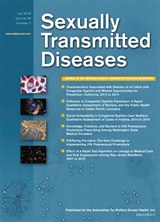Posted on June 28, 2018
Source: Sexually Transmitted Diseases

Impact of providing pre-exposure prophylaxis for HIV at clinics for sexually transmitted infections in Baltimore City: an agent-based model
Kasaie, Parastu, PhD; Berry, Stephen A., MD; Shah, Maunank S., MD, PhD; Rosenberg, Eli S., PhD; Hoover, Karen W., MD, MPH; Gift, Thomas L., PhD; Chesson, Harrell, PhD; Pennington, Jeff, BS; German, Danielle, PhD; Flynn, Colin P., ScM; Beyrer, Chris, MD, PhD; Dowdy, David W., MD, PHD
Background: Pre-exposure prophylaxis (PrEP) greatly reduces the risk of HIV acquisition, but its optimal delivery strategy remains uncertain. Clinics for sexually transmitted infections (STIs)
can provide an efficient venue for PrEP delivery.
Methods: To quantify the added value of STI clinic–based PrEP delivery, we used an agentbased
simulation of HIV transmission among men who have sex with men (MSM). We
simulated the impact of PrEP delivery through STI clinics compared with PrEP delivery in other
community-based settings. Our primary outcome was the projected twenty-year reduction in HIV
incidence among MSM.
Results: Assuming PrEP uptake and adherence of 60% each, evaluating STI clinic attendees and delivering PrEP to eligible MSM reduced HIV incidence by 16% [95% uncertainty range: 14% – 18%] over 20 years, an impact that was 1.8 [1.7 – 2.0] times as great as that achieved by evaluating an equal number of MSM recruited from the community. Comparing strategies where an equal number of MSM received PrEP in each strategy (i.e., evaluating more individuals for PrEP in the community-based strategy, since MSM attending STI clinics are more likely to be PrEP eligible), the reduction in HIV incidence under the STI clinic-based strategy was 1.3 [1.3 – 1.4] times as great as that of community-based delivery.
Conclusions: Delivering PrEP to MSM who attend STI clinics can improve efficiency and effectiveness. If high levels of adherence can be achieved in this population, STI clinics may be an important venue for PrEP implementation.